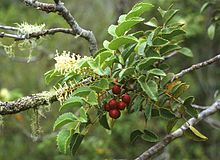Gevuina
| Gevuina | |
|---|---|

| |
| Chilean hazel with flowers and fruits | |
| Scientific classification | |
| Kingdom: | |
| (unranked): | |
| (unranked): | |
| Order: | |
| Family: | |
| Genus: | Gevuina
|
| Species: | G. avellana
|
| Binomial name | |
| Gevuina avellana | |

Gevuina avellana (Chilean hazel, avellano chileno in Spanish) is an evergreen tree, up to 20 meters (65 feet) tall. It is the only species currently classified in the genus Gevuina. It is native to southern Chile and adjacent valleys in Argentina. It is found from sea level to 700 meters (2300 feet) above sea level. Its distribution extends from 35° to 44° south latitude. The composite leaves are bright green and toothed, and the tree is in flower between July and November. The flowers are very small and beige to whitish, are bisexual and group two by two in long racemes. The fruit is a dark red nut when young and turns black. It can grow up straight or branched from the soil.
The name Gevuina comes from guevin, the Mapuche Indian name for the Chilean hazel.[1]
Taxonomy
Gevuina is a genus of either 1 or 3 species of the family Proteaceae. In some classifications, Gevuinia is recognised with three species endemic to each of Australia (Gevuina bleasdalei), New Guinea (Gevuina papuana), and one species in Chile and Argentina (Gevuina avellana). Other taxonomic reports place the Australian and New Guinea species in the genus Bleasdalea[2] or in the Fijian endemic genus Turrillia, and leave Gevuina with only Gevuina avellana.[3] The Flora of Australia retains these 2 species in Gevuinia,[4] but the most recent classification places the Australian and New Guinea species as Bleasdalea bleasdalei and B. papuana[5]
Uses and cultivation
The seeds are eaten raw, cooked in boiling water or toasted. The nuts contain about 12 percent protein, 49 percent oil, and 24 percent carbohydrates.[6] The seed has a very high concentration of monounsaturated oils and is also obtained for several purposes in Chile. It is rich in antioxidants such as vitamin E (α-tocotrienol) and β-carotene. Its oil is an ingredient in some sunscreens. Gevuina oil is a used as cosmetic ingredient for its moisturizing qualities and because it is a source of omega 7 fatty acids (palmitoleic acid).[7][8]
The tree is a good honey plant for bees and is also cultivated as ornamental. . The seed shells contain tannin that is used for tanning leather. The tree has an acceptable frost resistance (at least −12 °C (10 °F)) when mature. The wood is cream-colored with dark brown streaking and is used in cabinetry and musical instruments. It was introduced to Great Britain in 1826. It grows well there and in New Zealand and California. A few specimens are cultivated in Spain[9] and in the Pacific Northwest of the United States.[10] It grows well in temperate oceanic climates with cool temperatures where frosts occur commonly in winter, and has thrived in southern New Zealand. It needs 5 years to first harvest and 7 or 8 years for full production. In Seattle, Washington, squirrels and birds eat seeds from te trees. Most nuts that are for sale are gathered from the wild, but new varieties of greater yield are being developed in both Chile and New Zealand.
Gallery
-
Leaves and flowers
-
Twig
-
Flowers and fruits
-
Fallen nuts
References and external links
- ^ "Gevuina avellana". Enciclopedia de la Flora Chilena. Retrieved 2009-06-27.
- ^ A.C.Smith & J.E.Haas, 1975. American Journal of Botany, 62: 142.
- ^ A.C.Smith, 1985. Flora Vitiensis Nova 3: 754.
- ^ http://www.anbg.gov.au/abrs/online-resources/flora/stddisplay.xsql?pnid=45203
- ^ Weston; Barker, Nigel P. (2008). "A new suprageneric classification of the Proteaceae, with an annotated checklist of genera". Telopea. 11 (3): 339.
- ^ Facciola. S. Cornucopia - A Source Book of Edible Plants. Kampong Publications 1990 ISBN 0-9628087-0-9
- ^ A Bertoli, C.; et al. (1998). "Characterization of Chilean hazelnut (Gevuina avellana Mol) seed oil". Journal of the American Oil Chemists' Society. 75 (8): 1037–1040. doi:10.1007/s11746-998-0283-5.
- ^ FR 2681530 A1 (SO.F.I.A. Cosmetiques (S.A.R.L.)) 26.03.1993
- ^ "Plantas de la flora de Chile cultivadas en España" (PDF). José Manuel Sánchez de Lorenzo-Cáceres. Retrieved 2009-06-27.
{{cite web}}: Unknown parameter|trans_title=ignored (|trans-title=suggested) (help) - ^ "Gevuina avellana in Washington Park Arboretum" (PDF). Seattle Government. Retrieved 2009-06-27.
- Rodríguez, Roberto; Mathei, Oscar y Quezada, Max. 1983. Flora arbórea de Chile. Universidad de Concepción. 408p.
- Donoso, C. 2005. Árboles nativos de Chile. Guía de reconocimiento. Edición 4. Marisa Cuneo Ediciones, Valdivia, Chile. 136p.
- Hoffmann, A. 1982. Flora silvestre de Chile zona araucana. Edición 4. Ediciones Fundación Claudio Gay, Santiago, Chile. 258p.
- Muñoz, M. 1980. Flora del Parque Nacional Puyehue. Editorial Universitaria, Santiago, Chile. 557p.
- "Gevuina avellana". Enciclopedia de la Flora Chilena. Retrieved 2009-06-27.
- "Gevuina avellana in Scotland". PlantenTuin Esveld. Retrieved 2009-06-27.
- "Gevuina avellana: Potential for commercial nuts". Acta Horticulturae. Retrieved 2009-06-27.
- "A cool climate nut of the Proteaceae plant tropical family" (PDF). New Zealand Crop & Food Research. Retrieved 2009-06-27.




